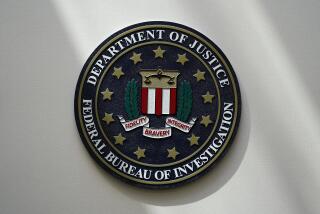Missing Laptop Had Secret Arms Data
WASHINGTON — The laptop computer missing from the State Department contained thousands of classified documents about arms proliferation issues, including highly sensitive information about the sources and methods of U.S. intelligence collection, State Department officials said Friday.
The State Department still has not found the computer, which vanished in January from a conference room, according to a senior State Department official. Its disappearance was reported to the department’s Bureau of Diplomatic Security in early February, according to another official.
If the laptop was stolen for the information it contained about the spread of sophisticated weapon technology, the theft would represent one of the most serious single losses of classified information ever by the United States, said a source familiar with the case.
Several sources in the department said that Secretary of State Madeleine Albright is “furious” about the security lapse and is once again considering the transfer of responsibility for top-secret information from the Bureau of Intelligence and Research (INR) to the Bureau of Diplomatic Security.
Within the State Department, INR handles all government intelligence reports classified as “sensitive compartmented information,” while diplomatic security handles less-sensitive documents with lower levels of classification. The laptop contained “code word” information, a classification higher than top secret.
Many State Department security officers, members of Congress and other government intelligence officials have been asking why sensitive information about the spread of missile technology and nuclear, chemical and biological weapons was stored in a portable laptop instead of a fixed desktop computer.
After the Washington Post first reported that the laptop was missing, the chairman of the House International Relations Committee, Rep. Benjamin A. Gilman (R-N.Y.), said he would hold hearings on allegations of lax security at the State Department.
A senior State Department official said Friday that the laptop was never supposed to leave the INR conference room in which it was kept. The senior official said a laptop was used instead of a desktop computer so that different people with clearance could use the computer and access its information without having to switch chairs.
State Department officials said they still hope to recover the laptop if it was stolen simply for the value of the computer hardware rather than the information it stored. The FBI has joined the search and the examination of suspects, including contractors who have been renovating the area, the official said.
A person familiar with the laptop incident said an official had propped open the door of the secure conference room, that contractors lacking security clearances were working in the sensitive area, that the contractors were not properly escorted and that the laptop had not been properly secured.
The laptop incident is the latest of a string of embarrassing security breaches at the State Department. Last year, counterintelligence officials from the FBI discovered a Russian spy lurking outside the department and, later, an eavesdropping device carefully planted in the wall molding of a conference room inside.
In 1998, a man dressed in a tweed coat strolled into an executive secretary’s office, six doors down from the office of Albright, helped himself to a sheaf of classified briefing materials in plain view of two secretaries, and walked out. The man was never identified and the materials never recovered.
Meanwhile, the Defense Department’s inspector general said in a report Friday that more than 900,000 people are awaiting Pentagon security clearances while the unit responsible for conducting background investigations struggles with a huge backlog and computer problems.
The Defense Security Service has started, but not completed, background checks on about 400,000 of those people, who include military personnel, civilian Pentagon employees and workers at private firms with defense contracts requiring security clearances, the report said.
In addition, the service has not even begun checking on 505,000 civilian and military personnel who were cleared for classified information years ago and are due for periodic reinvestigation, said the agency’s director, retired Lt. Gen. Charles J. Cunningham Jr.
More to Read
Sign up for Essential California
The most important California stories and recommendations in your inbox every morning.
You may occasionally receive promotional content from the Los Angeles Times.










